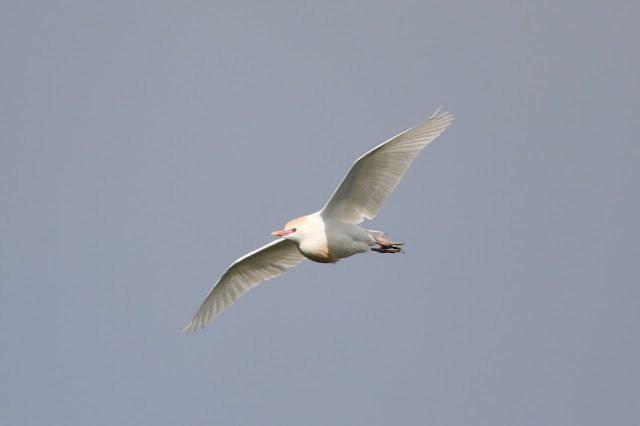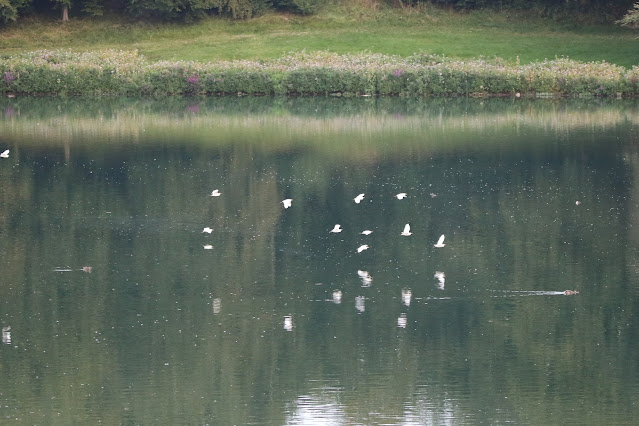For the third year in a row, Cattle Egrets have had a successful breeding season at Blenheim. This blog post is both a dump of some of my photos and my assessment of their breeding season based on fairly regular visits. After an absence over the winter in the county, the first returning birds appeared in their usual spot on the Queen Pool island on 30th March after what was a bit of an anxious wait. It seems the cold spells during the winter forced the birds south whereas in the previous winter they were able to remain local throughout, mainly around north Oxford. I checked my records and the arrival date at Blenheim in 2022 was 22nd March. 30th March this year also included an osprey at Blenheim, so a memorable day for me.
Two pairs were nest building in early April on the Queen Pool island although the nests themselves were very difficult to see. A fifth adult in breeding plumage appeared on 18th April and by 26th April there were 7 adults present. The original two pairs appeared to be settled on nests and presumably incubating eggs. To begin with I found them more difficult to monitor this year and although I'm not certain I believe the first two nests failed. Sightings dropped during colder weather in April and May and by mid May I was only seeing one pair regularly, and this appeared to be a third pair prospecting the island. I could no longer see birds on the earlier nests. This third pair I believe did go on to successfully raise young.
Two adults in breeding plumage on 10th May
Breeding plumage adult 15th May I also hadn't seen any evidence of young in June by which point I would have expected those from the first nests to be branching and therefore easier to see. But the vegetation on the island is dense in places and it was very hard to be certain. The presence of juvenile little egrets didn't always make it easy to be certain given views often weren't clear.
Fortunately the dredging work that took place during the summer didn't seem to bother the egrets as it was more of a threat to the birds that nested around the edge of the island such as the coots, grebes and a pair of common terns.
The backdrop and often of concern was the dredging work on the Queen Pool
By the end of June there was another pair nesting and by early July, probably two pairs with nests. Chronologically these were probably the fourth and fifth nests.
Adults nest building 30th June
By mid-July it was clear there were now some juveniles present confirming some success from the earlier attempts.
The three images above were all from 12th July showing adults and juveniles, some fledged, some not.
By the beginning of August the fourth pair had three well grown young not too far from fledging. The fifth pair were also still on the nest. In comparison, by the middle of August 2022 all had fledged and left by that point and weren't roosting there any longer. I wonder whether the varied weather we've had this summer accounts for the more staggered nesting this year?
Adults and young from what I believe was the fourth nest on 21st July
The adults were not being seen regularly (by me at least) at nearby sites they had used to feed in the previous two years. Enslow was a much used site in the previous two years and birds would often feed in the fields adjacent to the road next to the river Cherwell. I only saw a single adult there this year on one occasion on 31st July.
Adult at Enslow 31st July
A week later on 6th August I chanced upon a juvenile at Ardley ERF, another of my favourite local sites. It spent a couple of weeks there on and off and was more than likely one of the Blenheim birds.
The four images above were from 6th and 7th August at Ardley ERF
During August and early September there were six juveniles from the final two nests on the Queen Pool island, with a good few weeks age difference between the nests. For whatever reason they were far easier to see than those from earlier in the season. The first decent view I got of the young from the final nest was on 1st September where I could see three young.
A juvenile from the penultimate nest on 18th August yet to fully fledge
Adult and three juveniles from the final nest on 1st September
Towards the end of August is was obvious the majority of birds were leaving Blenheim each morning in a northerly direction, which was different to the usual easterly bearing. It didn't take too long to locate them about a mile north of Blenheim feeding in fields bordering the River Glyme between Woodstock and Wootton. Up to 18 birds were there at times feeding wherever the cattle were.
Birds feeding near Stratford Bridge, north of Woodstock 6th September
On 6th September I spent the evening at Blenheim to see how many roosted, and including the juveniles present there were 31 birds on the Queen Pool Island. They all roosted in the same conifer tree, along with 10 little egrets and at least 30 cormorants. Quite a sight! I also repeated the visit on 7th September and 26 roosted. This number was recorded by another birder a day or two later.
Above are birds flying from Blenheim to their feeding site north of Woodstock 7th September
Returning to roost on 6th and 7th September
I have been trying to guess how many cattle egrets must have been in Oxfordshire by the end of the summer. With reports from other sites it seems likely there must be at least 50 birds. I visited Otmoor on the morning of 10th September in hope that the Pallid Harrier might reappear. It didn't, but I had plenty of time to stand and watch about 10 cattle egrets moving around the reserve.
Otmoor 10th September
Easily my best views of the birds came on 14th September in the fields north of Woodstock. The cattle were at the ideal part of the field to give lovely views of the birds feeding among them. A couple of the adults still retained their breeding plumage, presumably the pair that still had young on the island at Blenheim.
All of the above photos from 14th September north of Woodstock
The 22nd September was the first day I didn't see any birds at Blenheim. The remaining three juveniles had left. There were no birds at all in the areas north of Woodstock either that day. Earlier in the week several birds including at least one juvenile flew south out of Blenheim early morning, quite possibly Otmoor-bound. There were no birds roosting on 25th September. Numbers at Otmoor seemed to have swelled which would suggest the Blenheim birds had now moved there. All in all they were present at Blenheim for nearly 6 months.
Certainly three pairs fledged young, possibly four. In total I think at least 8 juveniles, probably more, so another good year for them.
The final three juveniles on 15th September
One of the last remaining birds on 19th September




































Great summary of the year's events!
ReplyDeleteThanks Ben!
Delete